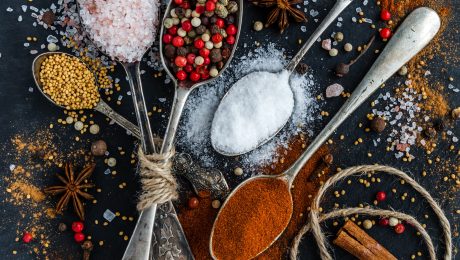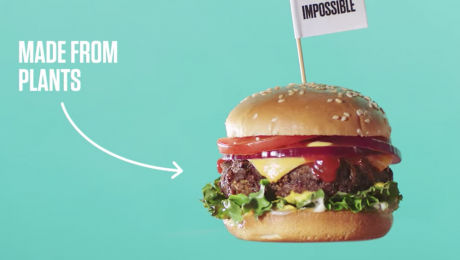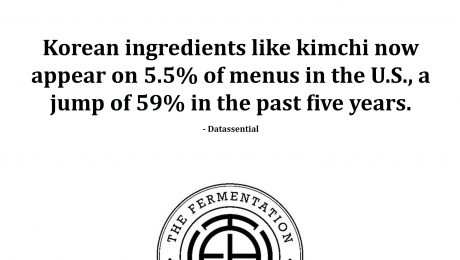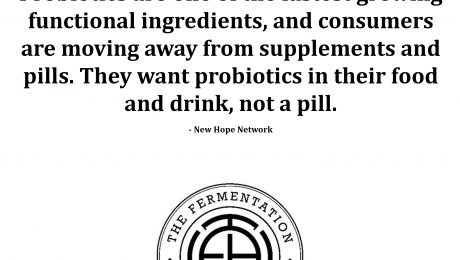MSG Myth Busting, Award-Winning Chefs Tout Benefits of Flavor Enhancer
In the next wave of “health” advocates slamming MSG, this week customers are upset Chick-fil-A includes MSG in their fried chicken. MSG often gets a bad rep as a preservative, but it’s a sodium salt naturally occurring in the human body and in whole foods (like tomatoes, mushrooms and potatoes). MSG is a umami-packed flavor enhancer that can be made as a flavoring agent through a fermentation process. Award-winning fermentation chefs like David Chang of Momofuku and David Zilber of NOMA use MSG in their dishes. A Today show article busts some of the common myths around MSG.
Read more (Today)
- Published in Food & Flavor
Athletes: Fermented Food & Drink Best for Performance Enhancement
Put down the Gatorade, athletes — the best performance-enhancing substance is fermented food and drinks. An article in sports magazine STACK says athletes are overlooking fermented products for workout nutrition. Fermented products — like raw sauerkraut, kimchi, yogurt and kefir — heal the body with beneficial bacteria and combat gut imbalances. “The better our digestion, the better we utilize the food we are putting into our body, leading to even better improvements in our strength and health,” the article states. Though there is little research in the field, the article points to one study which found probiotics helped female college athletes improve body composition and deadlift performance.
Read more (STACK)
- Published in Science
Future of Kombucha will be Local Brands, Educating Retailers & Adapting to Change
Kombucha brands biggest competition are not other kombucha brands – it’s soda and functional beverages. Sales continue to hemorrhage in the soda category as consumers shun sugar-filled drinks. And kombucha companies have a great opportunity now to grab that market share.
A panel of leaders in the kombucha and beverage industry shared their insights on the future of kombucha at KombuchaKon, Kombucha Brewers International’s 6th annual conference. They agreed the fermented tea is not a fad, but brands “have to be nimble and creative” to thrive in an increasingly crowded market.
“The future is really, really bright,” said John Peirano, the vice president of marketing at Humm Kombucha. “It’s super exciting – and we’re just getting started.”
Local Brands Will Reign
As more and more kombucha brands enter the industry, the brand’s biggest strengths will be selling to their regional market.
“There are all these local brands retailers are going to want because they care about what’s happening locally,” Peirano said. “Local brands are going to be really, really important.”
John Craven, editor of beverage industry news site BevNET, has covered the beverage world for nearly two decades. He said marketing brands locally works in the kombucha category, but not in any other beverage space.
“Prior to (kombucha), if you said ‘I want to build a regional brand,’ I would have said ‘That’s not a thing,’” Craven said.
Educating Retailer & Consumer
Retailers want to give \consumer’s a variety of product choices, Craven added. They’re more likely to commit to selling kombucha if there are multiple brands and SKUs on their store shelf.
“With (kombucha), it’s OK to like a bunch of different brands,” Craven said. It’s normal for a kombucha consumer to switch between different brands and flavors. “That is one thing this category has going for it that’s really unique. … It definitely has defied traditional beverage logic in that regard.”
Litigation against kombucha brands continues to top headlines, as lawsuits claim alcohol content is misrepresented or sugar levels are understated in different brands. In the next few months, KBI will be releasing their own standards defining kombucha.
Truth in labeling will drive trust with the consumer and the retailer, Peirano said. “It’s important that what’s inside the bottle is on the label,” he added.
“As category leaders, we also have to be category captains. We have to go to the retailers with really strong selling stories. And those selling stories aren’t just about Humm. Those selling stories are about the category and what will drive the most profitability for that retailer category and that shelf set, so they can be successful.”
Refrigerated kombucha and the fermented beverage category has grown 31.4 percent year-over-year, according to data from SPINS market research. And household awareness continues to climb – it increased 20 percent in 2018.
Kombucha is sold in the refrigerated section, some of the most expensive space on a grocery shelf.
“I think it’s all our responsibilities, if we want to continue to grow this category, we’ve got to go out and education and tell people about the magical, beautiful benefits of what kombucha brings to the table from a functional health standpoint,” Peirano said.
Brands Need to Remain Fresh
The kombucha industry is already dominated by a handful of national brands – GT Kombucha, Kevita, Health Ade, Humm Kombucha and Brew Dr. control the majority of market share. The panel agreed smaller brands can still successfully enter the category, but the top sellers are locked.
“There’s not room for a dozen million dollar-plus brands,” Craven said. “But the reality…is that some of these (smaller) brands will be acquired and will probably be absorbed and evolved, ruined, whatever, which makes an opportunity for the next brand to come along.”
“There are a lot of functional products out there…the beverage history lesson is consumers are really fickle,” Craven added. He pointed to Vitamin Water as an example, a brand that rapidly grew popular in the beverage industry but then lost sales. “The consumer keeps moving on to the flavor or the function of the month, so to speak.”
Craven does not think kombucha will be a victim like Vitamin Water because kombucha includes value-added health benefits. The kombucha brands that survive the next decade, though, must be adept to change. They must evolve with new flavors and brewing styles, while maintaining affordability, consistency and health benefits.
Growing Kombucha Enhancement: CBD
One of those kombucha styles keeping the industry fresh: CBD. Conrad Ferrel, founder and CEO of True Büch, said combining the benefits of the cannabis plant with the functional compounds in kombucha makes sense.
“The evolution of cannabis used with kombucha, it’s a natural marriage,” Ferrel said. “If you want to have kombucha for sleep, there will be a specific kombucha for that. If you want it for pain management, it will be there. It will be functional and specific to the certain (medical aid) people want.”
There are 140 compounds in the cannabis plant, but so far only two – THC and CP – have been studied, added Ferrel. CP is a value-added compound, known to aid in improving medical ailments. But science is lagging.
“As the world gets used to the science … the struggle is to sell people something that for years was considered a drug, now we’re trying to sell people on the fact that it’s good for you,” Ferrel added.
Hard Kombucha Gaining Traction
Hard kombucha is another brewing style keeping the kombucha category competitive. It’s evidence of how many beverage categories kombucha bleeds into – like alcohol, tea, juice, flavored water and functional beverages.
Kyle Oliver, quality assurance scientist at Boochcraft, said regular kombucha has an ABV of .5 percent to 2 percent. Hard or high alcohol kombucha goes above that level. Boochcraft has 7 percent ABV. The ABV is higher because hard kombucha goes through a secondary fermentation process, where more yeast and sugar are added.
“Our organisms we want in our kombucha are spoilage organisms in other industries (like wine and beer),” Oliver said. “The higher ABV doesn’t kill probiotics, they’re able to still grow in that environment.”
- Published in Business
Company Behind Fermented Meat Alternative Impossible Burger Becomes $2 Billion Company
Fermentation-based Impossible Foods — which makes a meat alternative with its own heme from yeast fermentation — is now a $2 billion company. The company behind the Impossible Burger raised an additional $300 million in funding, reflecting investor demand for meat alternatives. The meat-free burger cooks and tastes like meat — many consumers say they can’t tell the difference between Impossible Burger and ground beef. Impossible Foods partnered with Burger Kind earlier this year for the launch of the Impossible Whopper, a meatless burger that received rave reviews.
Read more (Vox)
- Published in Business
Korean Ingredients — Like Kimchi — Appear on 5.5% of U.S. Menus
Korean ingredients like kimchi now appear on 5.5% of menus in the U.S., a jump of 59% in the past five years. – Datassential
- Published in Business
How Can Craft Cheese Keep Up With Boom of Craft Beer Industry?
Craft cheese sales lag behind craft beer sales, despite the similarities in the two industries. Craft beer sales in America totaled $27.6 billion in 2018, while craft cheese sales totaled $4 billion. Experts tell VinePair why cheese doesn’t keep up with beer’s growth: cheese’s short lifespan (less than two months), greater risk of cheese mishandling by a distributor during the supply chain and the high price of artisan cheese. What can a cheese brand do? Experts advise increasing social media promotion. Craft beer has thrived on social media because people love seeing the hops being picked, brewers experimenting near the fermentation tank and the beer displayed in glassware. Craft cheese brands don’t self promote the same creation process, like a goat that made the milk or a family that runs the dairy farm. Cheese brands could also benefit from better merchandising, experts say. Beer labels are constantly and creatively changed and updated, but cheese labels remain the same for years.
Read more (VinePair)
- Published in Business
Fermentation Reigns: Sour Taking Over Our Tastebuds
Sour is taking over our taste buds. A New York Times Style Magazine article explores how sour flavor is “dominating our dining discourse.” The article lists fermenting, kombucha, sourdough, kimchi, drinking vinegar, cocktail shrubs and sour beer as evidence of sour’s ascent in American’s palates. Samin Nosrat, author of the book of cohost of the Netflix series both titled “Salt, Fat, Acid, Heat,” says acid is one of the building blocks of flavor and makes our mouth water. “...your body gets confused — maybe I want more?”
Read more (New York Times Style Magazine)
- Published in Food & Flavor
Snacking: Massive Industry with Big Growth
Snacks are a huge $1.2 trillion category, and it’s continuing to grow. Seventy-five percent of the global population snacks every day, while millennials snack four times a day. But consumers are looking for nutritious snacks. They want snacks with functional ingredients, great taste and low sugar.
Fermentation brands looking to grow need to transform their product into snackable sizes. Research by Mondeléz International’s new venture, Snack Futures, found that fruit and vegetables are the most popular snack item, but consumers want more than just a fresh apple. Innovation is key.
“Consumer obsession is driving a new model of snacking,” said Laura Shulman, founder and president of Food Future Strategies, Inc. From beverages to bars and bags to bites, “We’ve become this culture of serial snackers.”
At Natural Products Expo West, Shulman encouraged brands to be “snack innovators,” converting ideas to business.
Snacking’s Staying Power
The snacking surge is attributed to busier lifestyles – commute times are longer, more mothers are working and fewer people eat traditional three meals a day at home.
“Snacking is different than food. Snacking is a behavior. That behavior around the world is growing rapidly, and it’s growing much faster than center store [grocery aisle] food,” said Tim Coffer, chief growth officer at Mondeléz International. “We’re very bullish on snacking, and I think all of you should be, too, as you look for opportunities for growth.”
Snacking is disrupting the food industry, evident on the Expo West show floor where brands are seeing big returns on convenient, healthy food and drink products.
“The movement is more nutrient-dense snacks,” said Rohan Oza, co-founder and managing partner of Cavu Venture Partners. “Every company out there needs to be focused on how they create greater nutritional value on snacks that allow people to feel better about themselves.”
Brands as Health Warriors
Snacking of yesteryear evokes images of bags of potato chips or cans of soda. Those items are a far cry from modern snacking trends. Snacking must be nutritious because consumers are snacking with intention. They want snacks to be natural, simple, authentic and functional.
Brigette Wolf, global head of Snack Futures at Mondeléz International, said brands need to be “health warriors.” She encouraged brands to use medical and scientific studies and consumer research to “actively be the snacks of tomorrow.”
Growing Preference: Prebiotics & Probiotics
Consumers are also focusing on gut health. Research by New Hope Network found that sales of food and beverage with functional ingredients grew 7.5% in 2018 to $68 billion in sales. Probiotics and prebiotics are one of the fastest growing functional ingredients.
Kara Landau, founder of Uplift Food, was an Australian nutrition expert before starting her food company. Known as the world’s first dietitian created functional food, Uplift Food products are gut healthy, prebiotic snacks. The food brand was her dram, as Landau specializes in gut health. The connection between gut health and mood is especially important to her.
“I feel like there was this gaping hole in the market for someone to take that stance,” Landau said.
“Ultimately, I think the science is going to continue to catch up and help in terms of the claims that are being made,” Landau said about food with prebiotics and probiotics. “There’s only going to be benefits to consumer’s diets to getting more of that nutrition into their diet.”
8 Tips to Growing a Snack Product
Food industry leaders stressed that the brands of yesterday will not be the brands of tomorrow. Major food corporations are struggling to maintain sales as modern consumers search for healthier food, sustainable brands and startups with purpose.
Tips from Expo West “How Consumer Obsession is Driving A New Model of Snacking Innovation” panelists:
- Be consumer obsessed. Coffer with Mondeléz declared: “We are very clear who our boss is. … If you take care of the consumer, the rest of the stuff will fall right into place.”
- Reinvent testing. “The old model of how to innovate, how to test with consumers, that’s yesterday’s news,” Coffer continued. “Get with consumers – not in controlled environments.” Prototyping and testing needs to be at a much more rapid pace.
- Build a brand with a mission. Successful brands create a lifestyle around their product. “Build a culture out of it,” said Oza with Cavu Venture Partners.
- Don’t be cheap. Brands that have good ideas but aren’t spending the right budget amount to execute their plans are going to fail, said Oza.
- Remember: taste is king. “It’s America, we will not sacrifice on taste. In Japan, they certainly will. [But in America], you have to make it taste good,” Oza said.
- Experiment with ancient ingredients. From ashwagandha to turmeric, the ingredients of our forefathers are coming back into our food. “I think there’s room particularly in the states for taste buds to expand,” said Janet Planet, head of ideas at Fahrenheit 212.
- Start super small. Wolf of Snack Futures suggested putting a new product in a local yoga studio and see how people react. Give it to family and friends to test for feedback. Start with a small attraction, then go bigger.
- Convenience stores are ready for a disruption. Convenience stores are arguably the worst places today in terms of health food, but they’re still a hot spot for snacks.
- Published in Business
Functional Food & Beverage Sales Grew 7.5% to $68 Billion in Sales
Functional food and beverage sales grew 7.5% in 2018 to $68 billion in sales. Probiotics are one of the fastest growing functional ingredients, and consumers are moving away from supplements and pills. They want probiotics in their food and drink.
- Published in Business
Consumers: Let Plant-Based Foods Continue to Use Dairy Labels
Consumers are in favor of allowing plant-based food to use traditional dairy terms on their labels — but dairy farmers are strongly opposed to it. Last year, the U.S. FDA issued a public comment period to examine if plant-based foods and beverages should use the traditional dairy names: milk, cheese and yogurt. The results are out. Of those comments, 76 percent were in favor of using dairy terms on plant-based products, 13.5 percent were against and the remaining 10.5 percent were inconclusive. Of the commenters that identified themselves as dairy farmers, nearly all were opposed. Dairy farmers are concerned consumers will believe plant-based foods are nutritionally similar to cow’s milk (94 percent) and that consumers are being misled with a dairy term on a plant-based item (91 percent).
Read more (Linkage Research)
- Published in Business










